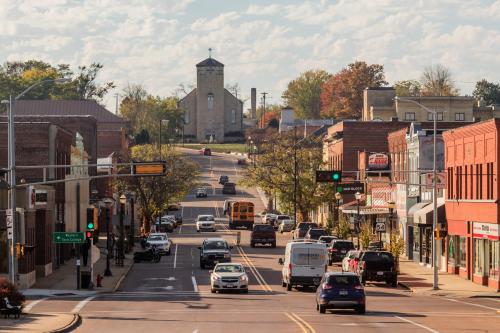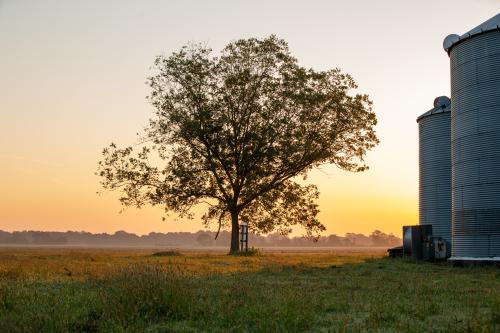This is the first in a two-part blog series capturing lessons from the first season of the “Reimagine Rural” podcast and offering policy recommendations to improve the effectiveness of federal rural policy. Note that many links in this article will take the reader to specific interviews featured in the podcast.
In this first season of the “Reimagine Rural” podcast, I talked to local leaders, investors, and small-business owners from rural towns across the U.S. that are making progress amid economic and social change. We don’t often hear about what is going right in rural America. The podcast gave me an opportunity to visit bright spots—or at least places that have begun to emit a strong, steady glow—and glean lessons to help scale up success in other rural communities across the country.
The places were exceptionally diverse: geographically, racially, and economically.* Yet across such diversity, several themes consistently surfaced with implications for creating successful place-based policy—and not just in rural America. These lessons have relevance across a wide spectrum of places around the globe seeking to advance inclusive, sustainable development.
-
Local leadership is foundational
Jeff Yost, who has led the Nebraska Community Foundation for 25 years, recently described a fundamental development principle this way: “Communities can only be built and sustained by those who live and work there.” The podcast’s stories demonstrate the importance of local leadership—for understanding the community’s history, assets, and challenges; developing solutions that work; and creating and maintaining community momentum. Each episode had its own examples, from Lakota Vogel in Eagle Butte recognizing its residents were becoming “credit invisible” to Shamokin’s leaders creating a unique off-road recreation and conservation site from reclaimed mining land.
These protagonists are eminently practical, often focused on taking the next best step. Since mainstream narratives about rural places often focus on “loss,” their creativity, innovation, and entrepreneurial spirit are rarely acknowledged or elevated. For these people, living in a rural place is a choice, not a trap—many are homecomers who moved away and decided to return. Their leadership emanates from a deep pride of place and love for their community.
-
Collaborative leadership builds momentum
Momentum and agency increased when individuals came together in groups or coalitions to set priorities, brainstorm ideas, adapt and overcome challenges, and sustain their efforts over time.
Globe’s inclusive community planning process enabled residents, businesses, and other stakeholders to develop local priorities that resulted in multiple redevelopment projects. Shamokin benefited from the emergence of a new downtown business group; a new faith-based alliance; and a new economic development authority. The newly formed Drew Collaborative has been central to its town’s progress.
Perhaps these are not the fully realized “complex adaptive coalitions” that Tom Friedman of the New York Times has described as driving successful revitalization. But the groupings highlighted in the podcast generally enable stakeholders to come together across sectors and political party lines around one objective: making their town more livable and prosperous.
-
Rural places and institutions are often capacity-constrained and starved for investment
The capacity of local rural governments, and the institutions surrounding them, are generally limited. Our interviewees described governments led by part-time, volunteer elected officials and thinly staffed town halls under tight fiscal constraints, striving to provide basic services. This makes it difficult to piece together the “minimum viable rural ecosystems” that Jerry Kenney of the TLL Temple Foundation in East Texas has described as a precondition for initiating and sustaining positive change.
It also makes it difficult to identify, access, and manage the public and private investment necessary to strengthen their community’s resilience and reinvent its economy. The fragmented and duplicative array of federal programs, the complexities of applications, and the bias towards “scale” put rural places at a disadvantage. In every episode, local leaders described how match requirements can immediately put federal resources out of reach. Much of this federal assistance comes in the form of loans or loan guarantees, creating another hurdle.
-
Effective partners accompany and strengthen local capacity
Each of the towns that I visited benefited from a relationship with a rural development partner such as the Rural Community Assistance Corporation (RCAC) in Globe, Communities Unlimited in Dewitt, SEDA-Council of Governments in Shamokin, and Woodlands Development & Lending in Thomas and Davis. These partners offer expertise, ingenuity, and experience with public processes and resources, and are essential in helping local leaders fill the gaps in their expertise. The way they provide assistance is as important as the assistance itself: They seek to accompany and empower local leaders and institutions to build their self-reliance and long-term capabilities.
Many of these takeaways were unsurprising but deepened our understanding of issues that had previously surfaced in our research. I also encountered some unexpected lessons:
-
Beauty is a core development strategy
From the very first interview, I was surprised by how often and how strongly these protagonists emphasized beauty. From former Shamokin mayor John Brown and his wife leaving potted flowers and notes on the porches of well-kept houses, to Kathy Vetovich buying a building simply “to make it beautiful,” this theme surfaced in some shape or form in every episode. This fits with Jenna Bednar’s analysis that beauty is a key pillar for reimagining and strengthening governance; the podcast’s stories are evidence that “A commitment to beauty reminds us that community can be embodied in a physical place.“
Rather than developing a grand economic strategy, my interviewees’ initial steps were more often focused on improving the quality of life, amenities, and attractiveness of their towns: Globe’s new aquatic center and efforts to make downtown prettier, Drew’s new playground and pavilion for community gatherings, Dewitt’s organizing to attract investment for its court square—these have been instinctual moves but reflect new research spearheaded by Amanda Weinstein suggesting that investments in quality of life and place are among the most effective tools for generating economic development.
-
Community identity, history, and psychology set the stage
These leaders were honest about having to push against apathy, negativity, and even resistance locally. They described a deficit of hope among their neighbors, with links to different factors: the trauma of past economic shocks or political marginalization; the failure of former revitalization attempts; lack of trust that key institutions—especially at the state or federal levels—have their best interests at heart; and a weakening of community associations and social fabric, with a diminished sense of agency.
U.S. policymakers have long associated productive work with human dignity (see a short history here from Brent Orrell of the American Enterprise Institute). Gene Sperling (now in the Biden White House) has advanced the idea of “economic dignity” to focus policy on improving a worker’s lived experience. Yet such precepts generally focus on individual workers. The people I interviewed instinctively understand that their communities have identities too, and that their community’s economic vibrancy, social activity, and downtown appeal contribute to a collective sense of dignity and worthiness.
A shared history lies at the heart of that identity. These leaders thus seek to affirm their community’s heritage and leverage the pride in its past, while also opening a portal to a new future that might be very different. It is important to honor the history and the community’s past contributions while demonstrating that it can grow into something new.
Time is of the essence—but this is also generational work
To adopt some terminology from Bill and Melinda Gates, my interviewees are “impatient optimists”—they place a premium on taking action, and they are eager to see their efforts bear fruit right now. Yet they have quickly become realists and realize that transformation will take time. In some cases, their situations were decades in the making; a reversal will require persistence and stamina. This requires a commitment to work at a meaningful scale while maintaining their efforts for the long haul. As Brendon Dennison of Coalfield Development remarked in episode eight, “This is generational work”: Their hope is that policymakers and investors recognize this and remain partners for the time it will take.
The momentum in these places adds a uniquely American flavor to the impetus for localization that has gained prominence in development practice across the globe. A primary task here in the U.S. is to ensure our public policy effectively meets the needs, and accelerates the progress, of rural stakeholders. These lessons provide a good basis from which to start.
*Shamokin, Pennsylvania is over 90 percent white; Drew, Mississippi, almost 90 percent Black; Eagle Butte, South Dakota, more than 90 percent Native American; and Globe, Arizona almost 50 percent Latino. DeWitt, Arkansas is known as the “rice capital of the U.S.” but is increasingly tied to the hunting and fishing nearby. Thomas and Davis, West Virginia are now home to a vibrant arts and recreation economy after the loss of its coal and timber industries.






Commentary
Policy lessons—and surprises—from the ‘Reimagine Rural’ podcast
May 1, 2023